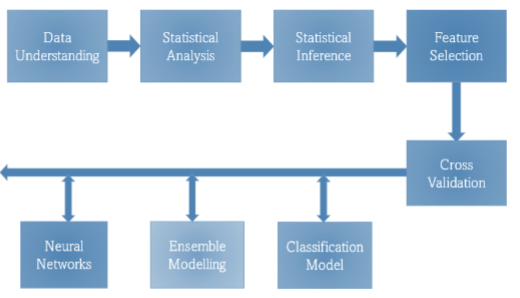A Statistical Modelling to Detect Carcinoma Cancer in Its Incipient Stages in Healthcare
Main Article Content
Abstract
Cancer is a public health problem on a global scale due to its high fatality rate and general complexity. The advancement of cancer prediction based on gene expression has been hastened by the rapid development of modern high-throughput sequencing methods and different machine-learning algorithms, offering insights into effective and precise treatment decision-making. Therefore, it is crucial to create Machine Learning (ML) algorithms that can tell cancer patients apart from healthy individuals. No one classification method has emerged as particularly successful, despite the widespread use of classification methods for cancer prediction. Using a multi-machine learning model optimization strategy, this research demonstrates how Deep Learning (DL) can be utilized to increase the accuracy of the models. We have chosen potential informative genes using statistical analysis, and we have been training five different classification models with these genes. The data from the five distinct classifiers is then "ensembled" using a deep learning technique. The great majority of cases are lung, stomach, and breast adenocarcinomas. Due to this, we applied deep learning-based methods to test the suggested inter-ensembles model using data from the cancer field. According to the research findings, using more than one set of classifiers or the conventional consensus approach improves the accuracy of cancer prognosis. The suggested deep learning-based inter-ensemble technique has been demonstrated to be accurate and effective for cancer diagnosis employing a wide range of classifiers.
Article Details
References
Zeng, Q., Klein, C., Caruso, S., Maille, P., Laleh, N. G., Sommacale, D., ... & Calderaro, J. (2022). Artificial intelligence predicts immune and inflammatory gene signatures directly from hepatocellular carcinoma histology. Journal of Hepatology, 77(1), 116-127.
Zhang, G., Sun, J., & Zhang, X. (2022). A novel Cuproptosis-related LncRNA signature to predict prognosis in hepatocellular carcinoma. Scientific reports, 12(1), 11325.
Yan, C., Niu, Y., Ma, L., Tian, L., & Ma, J. (2022). System analysis based on the cupro ptosis-related genes identifies LIPT1 as a novel therapy target for liver hepatocellular carcinoma. Journal of Translational Medicine, 20(1), 1-18.
Allugunti, V. R. (2022). Breast cancer detection is based on thermographic images using machine learning and deep learning algorithms. International Journal of Engineering in Computer Science, 4(1), 49-56.
Ramana, K., Kumar, M. R., Sreenivasulu, K., Gadekallu, T. R., Bhatia, S., Agarwal, P., & Idrees, S. M. (2022). Early prediction of lung cancers using deep saliency capsule and pre-trained deep learning frameworks. Frontiers in Oncology, 12.
Rudra Kumar, M., Pathak, R., & Gunjan, V. K. (2022). Diagnosis and Medicine Prediction for COVID-19 Using Machine Learning Approach. In Computational Intelligence in Machine Learning: Select Proceedings of ICCIML 2021 (pp. 123-133). Singapore: Springer Nature Singapore.
Zhou, X., Li, C., Rahaman, M. M., Yao, Y., Ai, S., Sun, C., ... & Teng, Y. (2020). A comprehensive review for breast histopathology image analysis using classical and deep neural networks. IEEE Access, 8, 90931-90956.
Saravana Kumar, K., & Ramasubramanian, S. A clinical decision support system for heart disease prediction with ensemble two-fold classification framework. Journal of Intelligent & Fuzzy Systems, (Preprint), 1-18.
Kumari, N., & Acharjya, D. P. (2022). Data classification using rough set and bioinspired computing in healthcare applications-an extensive review. Multimedia Tools and Applications, 1-27.
Alshayeji, M. H., Ellethy, H., & Gupta, R. (2022). Computer-aided detection of breast cancer on the Wisconsin dataset: An artificial neural networks approach. Biomedical Signal Processing and Control, 71, 103141.
Fatima, N., Liu, L., Hong, S., & Ahmed, H. (2020). Prediction of breast cancer, comparative review of machine learning techniques, and their analysis. IEEE Access, 8, 150360-150376.
Wisesty, U. N., Mengko, T. R., & Purwarianti, A. (2020, April). Gene mutation detection for breast cancer disease: A review. In I.O.P. Conference Series: Materials Science and Engineering (Vol. 830, No. 3, p. 032051). I.O.P. Publishing.
Pang, T., Wong, J. H. D., Ng, W. L., & Chan, C. S. (2020). Deep learning radiomics in breast cancer with different modalities: Overview and future. Expert Systems with Applications, 158, 113501.
Vasundhara, S., Kiranmayee, B. V., & Suresh, C. (2019). Machine learning approach for breast cancer prediction. International Journal of Recent Technology and Engineering (IJRTE), 8(1).
Ak, M. F. (2020, April). A comparative analysis of breast cancer detection and diagnosis using data visualization and machine learning applications. In Healthcare (Vol. 8, No. 2, p. 111). MDPI.
Taghizadeh, E., Heydarheydari, S., Saberi, A., JafarpoorNesheli, S., & Rezaeijo, S. M. (2022). Breast cancer prediction with transcriptome profiling using feature selection and machine learning methods. Bmc Bioinformatics, 23(1), 1-9.
Raad, A., Kalakech, A., & Ayache, M. (2012). Breast cancer classification using neural network approach: M.L.P. and RBF. Ali Mohsen Kabalan, 7(8), 105.
Elsayad, A. M. (2010). Predicting the severity of breast masses with ensemble of Bayesian classifiers. Journal of computer science, 6(5), 576.
Sylviaa, M. S. M., & Sudha, N. (2022). Review On Diagnosis for Early Stage of Breast Cancer. JOURNAL OF ALGEBRAIC STATISTICS, 13(3), 784-789.
Visser, I. J., Levink, I. J. M., Peppelenbosch, M. P., Fuhler, G. M., Bruno, M. J., & Cahen, D. L. (2022). Systematic review and meta-analysis: Diagnostic performance of D.N.A. alterations in pancreatic juice for the detection of pancreatic cancer. Pancreatology.
Haznedar, B., & Simsek, N. Y. (2022). A Comparative Study on Classification Methods for Renal Cell and Lung Cancers Using RNA-Seq Data. IEEE Access, 10, 105412-105420.
Chalapathi, M. M., Kumar, M. R., Sharma, N., & Shitharth, S. (2022). Ensemble Learning by High-Dimensional Acoustic Features for Emotion Recognition from Speech Audio Signal. Security and Communication Networks, 202

